Are you trying to learn more about the 1994 nickel? If yes, then you are in the right place. In this article, you will discover the composition, historical significance, and value of the 1994 five-cent coin.
What Is the 1994 Jefferson Nickel Made Of?
The 1994 Jefferson nickel is made of 75 percent copper and 25% nickel. The Jefferson nickel was first struck in 1938 and is still being issued by the US Mint today. The only time that the Jefferson nickel changed its composition was during World War II.
From 1942 to 1945, the Jefferson nickel and other US coins needed to change their composition. Nickel was an important raw material in producing bullets and weapons.
Congress asked the US Mint to remove nickel from the coins. The US Mint responded by using 56% copper, 35% silver, and 9% manganese. After the war, the US Mint restored the original cupro-nickel composition.

Felix Schlag designed the Jefferson nickel after winning the open competition held by the US Mint. Due to a misunderstanding, Schlag’s initials weren’t added to the nickel until 1966.
Nevertheless, the design of Schlag stood the test of time. His design was used from 1938 until 2004. In 2005, the nickel received a new design from Joe Fitzgerald. In 2006, it was then replaced by Jamie Franki’s design.
The obverse of the 1994 nickel features the image of Thomas Jefferson, the third president of the United States. On the reverse, you’ll find the front view of Jefferson’s mansion, the Monticello.
1994 Jefferson Nickel Varieties
The 1994 Jefferson nickel comes with four official varieties. These varieties differ in their mint mark and how they are struck. Aside from the official varieties, there are also error coins that made it out of the mint center.
Here is a summary of the 1994 Jefferson Nickel Varieties, along with their mintage:
| Variety | Mint Location | Mintage |
| 1994 D Jefferson Nickel | Denver | 715,762,110 |
| 1994 S Proof Jefferson Nickel | San Francisco | 3,269,923 |
| 1994 P Jefferson Nickel (Regular Strike) | Philadelphia | 722,160,000 |
| 1994 P Jefferson Nickel (Special Strike) | Philadelphia | 167,703 |
| Total | 1,441,359,736 |
After a few years, when the mintage figure of the nickel went below the one-billion mark in 1994, the US Mint once again produced more than a billion 5-cent coins.
Here’s a deeper look at each of the 1994 Jefferson Nickel varieties:
1994 D Jefferson Nickel
Year of minting: 1994
Mint Mark: D
Minted in: Denver
Quantity produced: 715,762,110
Face Value: $0.05 (five cents)
Price: $0.28 to $1.13 (circulated condition)
Mass: 5.00 grams
Edge: Plain
Designer: Felix Schlag
Composition: 75% Copper, 25% Nickel
Diameter: 21.20 millimeters
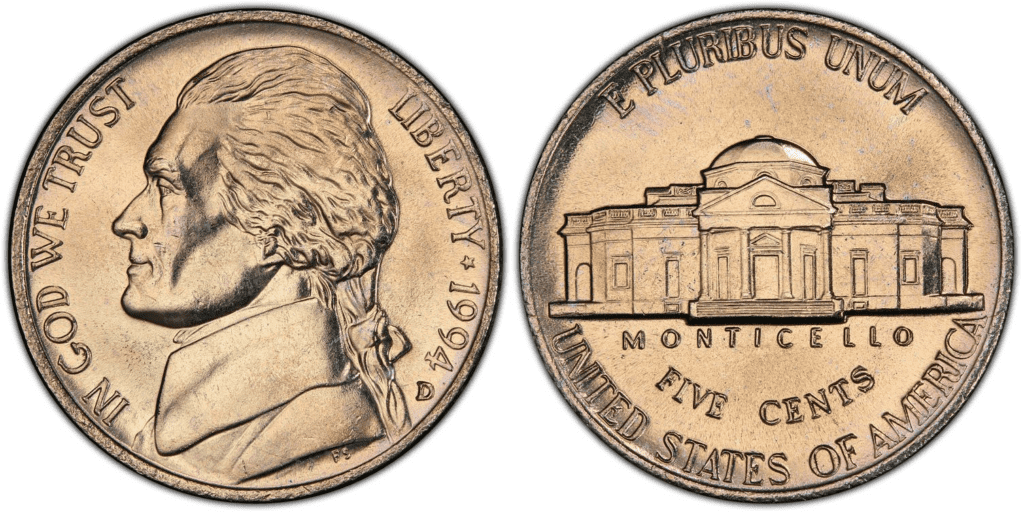
The Denver Mint bounced back in 1994 in terms of mintage. In 1993, the Denver Mint produced about 406 million nickels. Now, in 1994, they produced more than 715 million nickels, which almost surpassed the mintage figure of the Philadelphia Mint.
In 1995, the Denver Mint would produce even more nickels in a single year. Circulated 1994 nickels are priced at around $0.28 to $1.13.
1994 S Proof Jefferson Nickel
Year of minting: 1994
Mint Mark: S
Minted in: San Francisco
Quantity produced: 3,269,923
Face Value: $0.05 (five cents)
Price: $3.89 or more (Mint State)
Mass: 5.00 grams
Edge: Plain
Designer: Felix Schlag
Composition: 75% Copper, 25% Nickel
Diameter: 21.20 millimeters
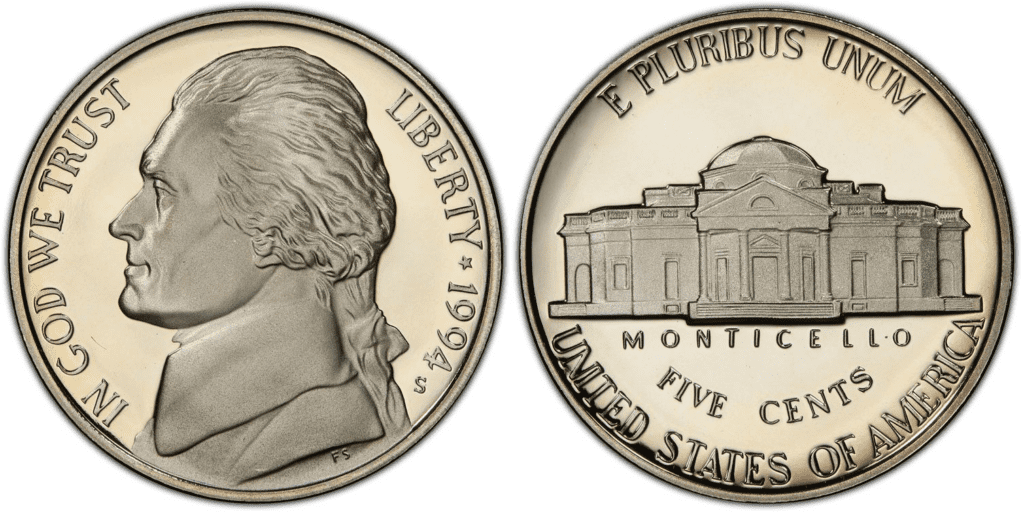
The 1944 S proof nickel coins are well-struck. They are so beautifully made that many of these coins are in PR70 grade. There’s also a good demand for nickel-proof coins; the San Francisco Mint produced more than 3 million.
1994 P Jefferson Nickel
Year of minting: 1994
Mint Mark: P
Minted in: Philadelphia
Quantity produced: 722,160,000
Face Value: $0.05 (five cents)
Price: $0.28 to $1.13 (circulated condition)
Mass: 5.00 grams
Edge: Plain
Designer: Felix Schlag
Composition: 75% Copper, 25% Nickel
Diameter: 21.20 millimeters
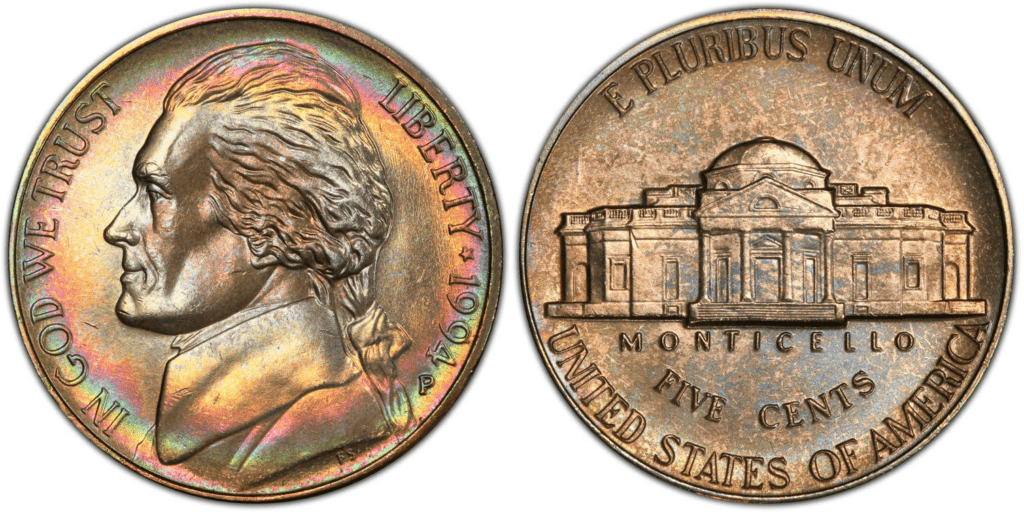
As expected, the Philadelphia Mint produced the most 1994 nickels. The Mint produced more than 722 million nickels in 1994. This is a huge increase compared to the previous year, 1993 when only about 412 million nickels were produced by the Philadelphia Mint.
1994 P Jefferson Nickel (Special Strike)
Year of minting: 1994
Mint Mark: P
Minted in: Philadelphia
Quantity produced: 167,703
Face Value: $0.05 (five cents)
Price: $55 (uncirculated condition)
Mass: 5.00 grams
Edge: Plain
Designer: Felix Schlag
Composition: 75% Copper, 25% Nickel
Diameter: 21.20 millimeters
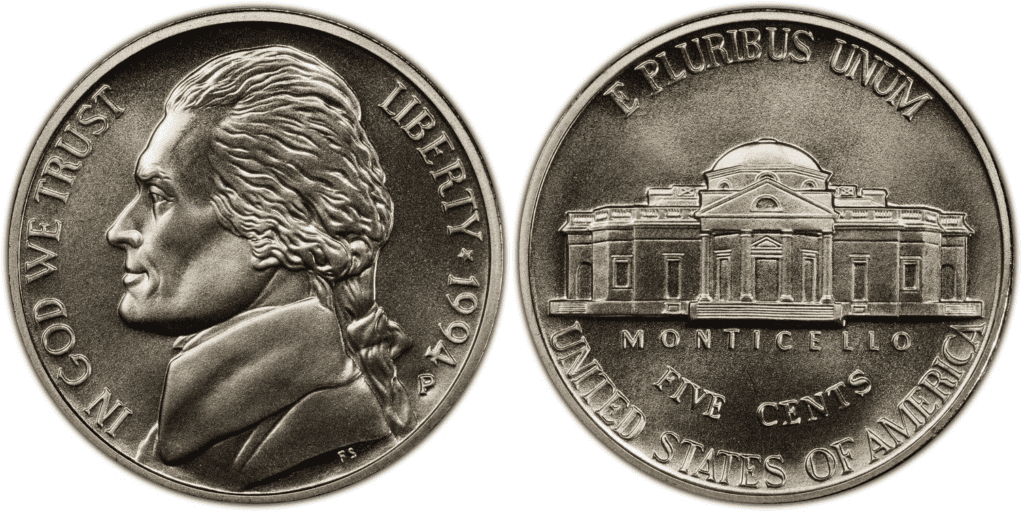
Aside from the regularly struck nickels, the Philadelphia Mint produced more than 167 thousand nickels with a special strike. These beautiful nickels come with a frosted matte finish. If you ever see one, you’ll notice that the coin has a grainy-like surface that makes the coin even more appealing.
The US Mint released the 1994 special struck nickels as part of the 1944 Thomas Jefferson Coinage and Currency Set. The set comes with the specially struck 1944 nickel plus a 1976 uncirculated $2 bill and uncirculated Thomas Jefferson Commemorative Silver Dollar.
The US Mint sold this set for $34 and then raised it to $39. Most 1994 especially struck nickels, are graded MS67 and above.
List Of 1994 Jefferson Nickel Errors
The US Mint produced more than 1.4 billion Jefferson nickels in 1994. So, this should not surprise you that error coins came from the Mint. While the US Mint might not like the error coins, many collectors are interested in them. Thus, it’s worth discussing examples of error coins.
Here are some 1993 Jefferson nickel error coins you should know:
Strike-through error
There are times when a foreign material goes between the die and nickel. As a result, the die doesn’t completely hit the coin. Depending on the foreign material, the strike-through error may cause the coin to look smudged, or there would be a peculiar marking.
Here’s an example of a strike-through error caused by grease:

Die break error
Due to wear and tear, the die can break at some point in the mintage process. When this happens, the die cracks and this crack would then leave a mark on the coin.
Here’s an example of a die break error that leaves a small line on Jefferson’s nose:
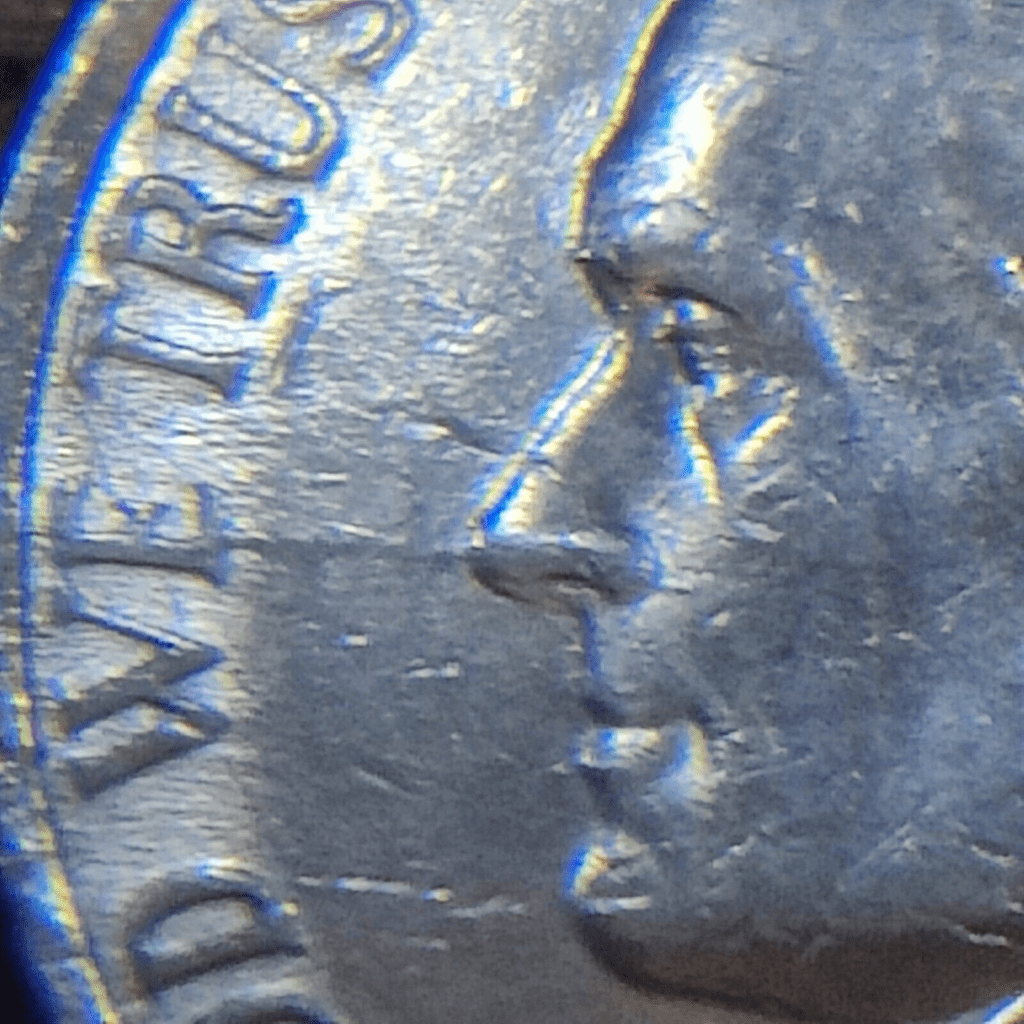
Improper annealing error
The process of annealing coins involves the heating and cooling of the planchet. If all goes well, the mixture of copper and nickel should properly distribute throughout the coin. However, in improper annealing, it is said that metal molecules begin to move toward the coin’s surface, forming a distinctive layer.
Here’s an example of an improper annealing error in a 1944 nickel:
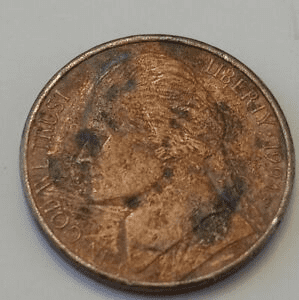
How Much Is 1994 Jefferson Nickel Worth Today?
The 1994 Jefferson nickel has a face value of 5 cents. It has a melt value of $0.0710. This is understandable since nickel doesn’t have any precious metal in it. You can trade the nickel for 5 cents. If you’re going to sell it and it has undergone circulation, you might sell it for $0.28 to $1.13.
While it is true that the Jefferson nickel issued in 1994 might not be that valuable in terms of its face value and melt value, it is still valuable in the eyes of numismatists. Check out this table of auction records, and you’ll see that the 1994 Jefferson nickel can still be worth a lot of money.
| Coin | Condition | Grade | Sold date | Sold by | Value |
| 1994 P Jefferson Nickel (Special Strike) | Perfect Uncirculated | SP 70 | February 3, 2010 | Heritage Auctions | $1,725 |
| 1994 D Jefferson Nickel | Superb Gem Uncirculated
|
MS 67 | April 30, 2012 | eBay | $1,356 |
| 1994 P Jefferson Nickel | Superb Gem Uncirculated | MS 69 (Full Steps) | February 10, 2013 | Heritage Auctions | $729 |
| 1994 S Proof Jefferson Nickel | Perfect Uncirculated
|
PR 70 (Deep Cameo) | July 2, 2001 | Heritage Auctions | $43 |
How Does The Grading System Work?
The most common way to grade a 1994 nickel is by using the Sheldon Scale. This scale was introduced by Dr. William Sheldon in 1949. The scale comes with a 70-point grading system. By looking at the coin’s luster, attractiveness, level of preservation, and condition, an appraiser would know what grade to give.
As you may know, coin grading has been difficult in the past. Initially, people would use terms such as used or new to grade a coin. Later on, more adjectives were used. Since these are too subjective, people often don’t agree with the grades others give. Thus, having the Sheldon Scale is a great help to ensure people have a standard to follow.
Aside from the Sheldon Scale, the coin would also be categorized as SP (Specimen), MS (Mint State), or PR (Proof). MS is for coins made for circulation. PR is for coins made as proof coins. SP is given to coins in the mint state but look proof coins.
Where To Buy Or Sell 1994 Jefferson Nickel?
The 1994 Jefferson nickel is available online and in stores. You can search the Internet for specific coins or visit coin shops and join auctions. You can also contact groups or clubs of coin collectors interested in buying your 1994 Jefferson nickel or who might have a 1994 Jefferson nickel that they can sell to you.
FAQs
How much is a 1994 D nickel worth today?
The 1994 D nickel has a face value of 5 cents. However, it can be more valuable if it is in good condition and has rare attributes. For example, a 1994 D nickel with a grade of MS67 was sold for $1,356 in April 2012.
What is a 1994 nickel made of?
The 1994 nickel is made of 75% copper and 25% nickel.
1993 Jefferson Nickel Value Guide
1993 Quarter Value Guide (Incld. Rare Varieties)
1994 Kennedy Half Dollar Value Guide
1994 Silver Dollar Value Guide
1994 Penny Value Guide (Incld. Rare Varieties)
1995 Kennedy Half Dollar Value Guide
1995 Jefferson Nickel Value Guide
1995 Penny Value Guide (Incld. Rare Varieties)
